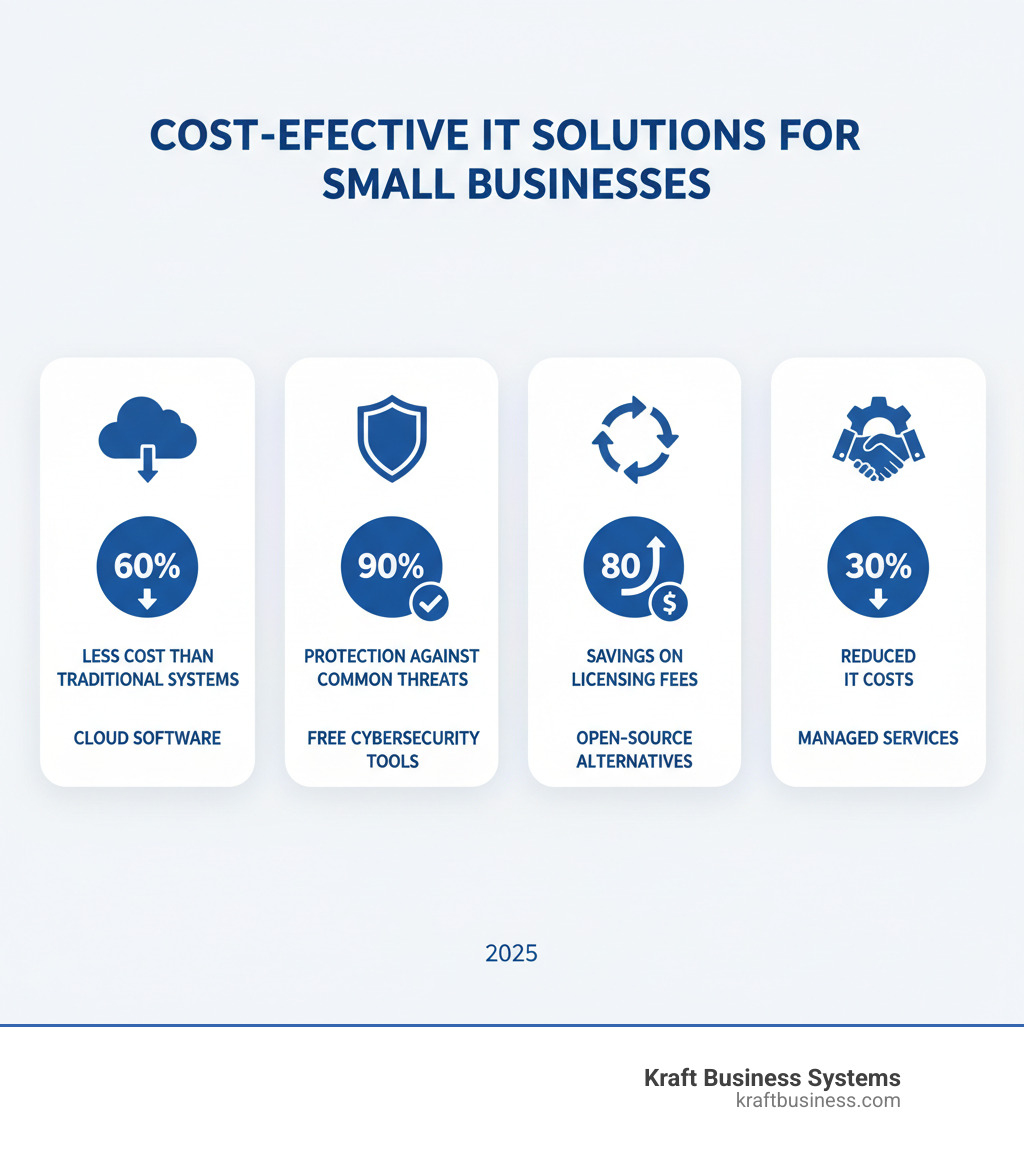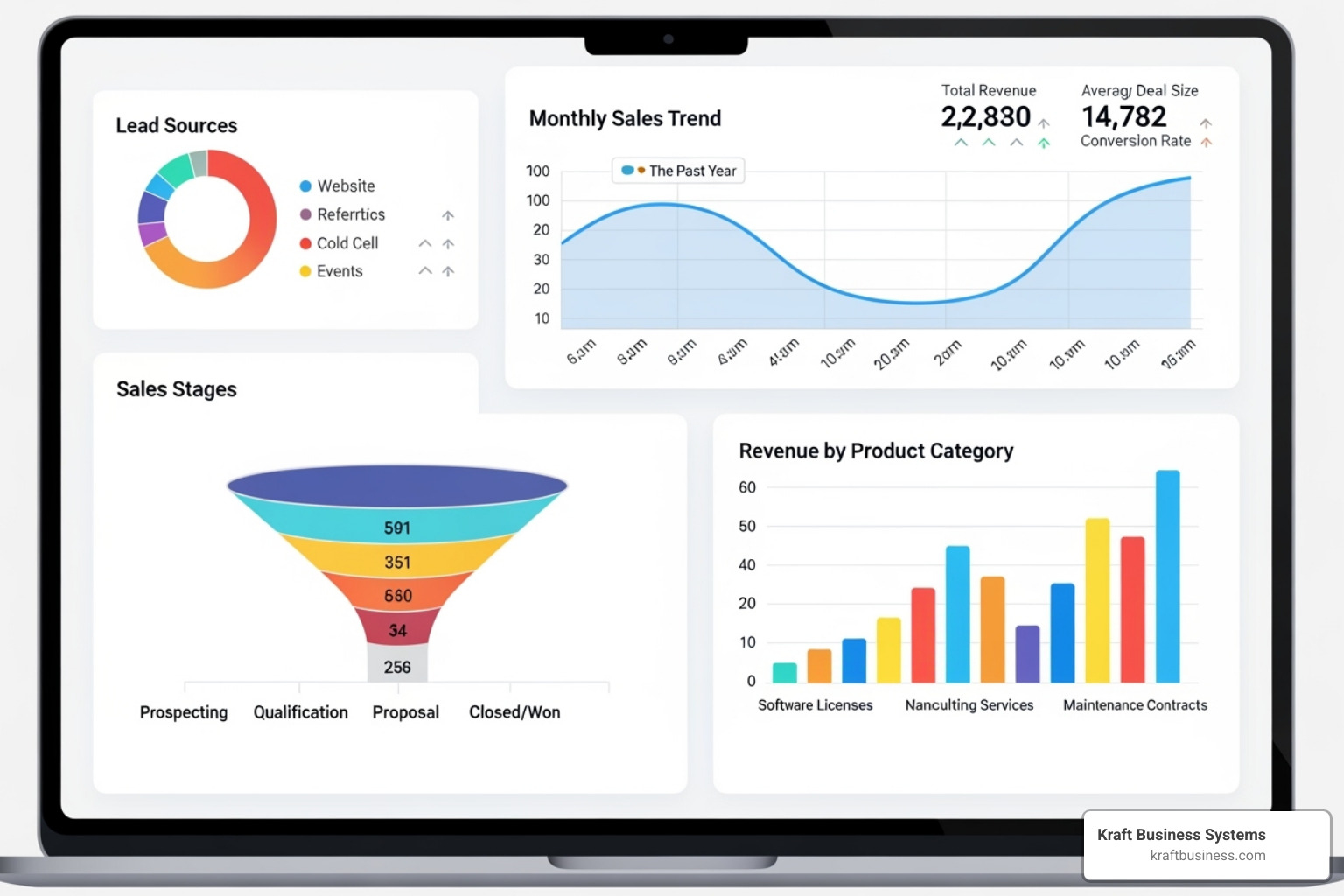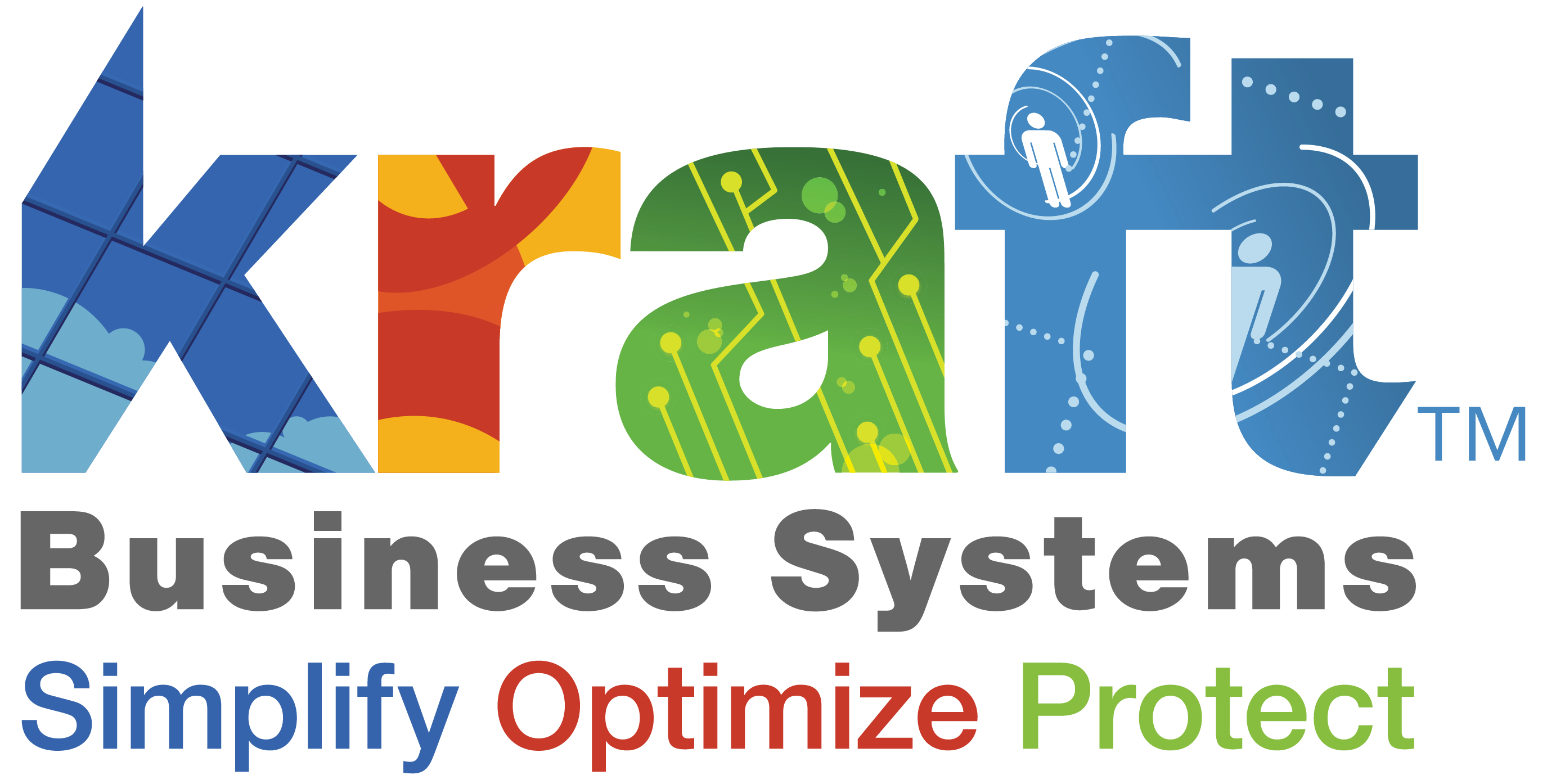AI Overview:
Small businesses can now compete like big companies by adopting cost-effective IT solutions that boost growth, security, and efficiency. Investing in tools like cloud computing, cybersecurity, CRM systems, data backup, and managed IT services helps streamline operations and prevent costly downtime. With proactive IT management and smart budgeting, small businesses can turn technology into a long-term competitive advantage rather than an expense.
Why Small Businesses Need Cost-Effective IT Solutions Now More Than Ever
Finding the right it solutions for small business doesn’t have to break the bank. While 80% of US small businesses aren’t taking full advantage of available digital tools, smart companies are finding budget-friendly alternatives that deliver real results.
Essential IT Solutions for Small Businesses:
- Cloud Computing – Access software and data from anywhere
- Cybersecurity Tools – Protect against the 43% of cyber attacks targeting small businesses
- Customer Relationship Management (CRM) – Track leads and boost sales
- Communication & Collaboration – Enable remote work and team productivity
- Data Backup & Recovery – Prevent the costly downtime that affects 80% of small businesses
- Financial Management Software – Automate invoicing and expense tracking
- Managed IT Services – Get expert support without hiring full-time staff
The digital landscape has shifted dramatically. What was once considered optional technology is now essential for survival and growth. Companies that leverage digital tools earn twice as much revenue per employee compared to those lagging behind.
But here’s the challenge: many small business owners assume enterprise-grade IT solutions are too expensive. The reality? There are proven, cost-effective alternatives that deliver the same core benefits without the premium price tag.
This guide reveals seven budget-friendly IT solutions that can transform your operations, strengthen your security, and fuel your growth – all while keeping costs manageable for small business budgets.
It solutions for small business helpful reading:
- business continuity planning IT
- cloud migration for businesses
- managed firewall services
The Foundational Tech Stack: Essential IT Solutions for Small Business
Building a successful small business today means having the right technology foundation in place. Think of it like constructing a house – you need solid groundwork before you can add the finishing touches. The good news? You don’t need to break the bank to get started.
The core IT solutions for small business success revolve around four key pillars: cloud computing that keeps you flexible, cybersecurity that protects your reputation, CRM systems that nurture customer relationships, and financial tools that streamline your operations. When these pieces work together, something remarkable happens – businesses that accept digital tools earn twice as much revenue per employee compared to those still stuck in the past.
Cloud Computing and Remote Work: The New Standard for Agility
Remember when working from anywhere seemed impossible? Those days are long gone. Cloud computing has transformed how small businesses operate, and frankly, it’s been a game-changer for companies throughout Michigan and beyond.
The beauty of cloud solutions lies in their accessibility. Your team can pull up critical files whether they’re at the office in Grand Rapids, meeting a client in Detroit, or working from their kitchen table. This flexibility isn’t just convenient – it’s become essential for staying competitive.
Scalability is another major win. Unlike traditional software that requires expensive upgrades every few years, cloud solutions grow with your business. Need more storage this month? Done. Scaling back during slower seasons? No problem. This flexibility helps keep your IT solutions for small business both current and cost-effective.
Here’s what really gets business owners excited: automatic updates. Your cloud provider handles all the technical maintenance, security patches, and feature updates behind the scenes. That means your team can focus on serving customers instead of wrestling with software updates.
The reduced IT burden alone can save small businesses thousands of dollars annually. Instead of maintaining servers and troubleshooting hardware issues, you’re essentially renting enterprise-level infrastructure at a fraction of the cost. Plus, cloud-based disaster recovery capabilities mean your data stays safe even if something happens to your physical location.
Essential remote work tools have become the backbone of modern business operations. Video conferencing platforms keep teams connected, project management software ensures nothing falls through the cracks, and secure file sharing services make collaboration seamless. Small business owners report saving an average of 10 hours weekly through automation – that’s over 500 hours annually that can be redirected toward growth activities.
When choosing cloud services, look beyond the monthly subscription fee. Consider the total cost of ownership, including training time and integration costs. Security should be non-negotiable – ensure your providers meet industry standards. Most importantly, verify that new tools will play nicely with your existing systems to avoid creating data silos.
Cybersecurity: Protecting Your Digital Assets and Reputation
Let’s address the elephant in the room: cybersecurity isn’t just a big business problem anymore. A staggering 43% of cyber attacks specifically target small businesses, and here’s the kicker – 60% of those attacked close their doors within six months. That’s not meant to scare you, but rather to emphasize why robust protection is crucial.
Building effective cybersecurity requires multiple layers of protection. Next-generation firewalls serve as your first line of defense, acting like sophisticated security guards that can identify and block advanced threats before they reach your network.
Zero-trust architecture might sound technical, but the concept is simple: verify everything and everyone before granting access. Instead of assuming that everything inside your network is safe, this approach checks every user and device. It’s like having a security checkpoint at every door instead of just the front entrance.
Endpoint protection ensures that every device connecting to your network – laptops, phones, tablets – has advanced protection against malware and ransomware. With remote work becoming standard, this protection extends far beyond your physical office walls.
Email security deserves special attention since 84% of small and medium businesses experienced phishing attempts in recent surveys. Advanced email filters catch malicious messages before they reach your team’s inboxes.
Employee training often gets overlooked, but it’s absolutely critical. Your team members are your first line of defense against social engineering attacks. Regular, engaging training sessions help everyone recognize suspicious emails and avoid common traps.
Data backup and business continuity planning can literally save your business. Here’s a sobering statistic: sixty-eight percent of small business owners don’t have a written disaster recovery plan. Don’t be part of that statistic. Automated backups and clear recovery procedures ensure you can bounce back quickly from any incident.
Having a solid incident response plan is like having a fire drill procedure – you hope you’ll never need it, but you’ll be grateful it exists if something happens. This plan outlines exactly how to contain an attack, preserve evidence, and restore operations efficiently.
More than 20% of cyber attack victims spent at least $50,000 and took longer than six months to recover. Investing in proper cybersecurity isn’t just about protection – it’s about preserving your business’s future.
Growth Engines: How CRM and Marketing Tools Drive Sales
Here’s where technology stops being just about efficiency and starts directly impacting your bottom line. Customer Relationship Management (CRM) systems and marketing automation tools are like having a dedicated sales and marketing team working around the clock.
Centralizing customer data eliminates the chaos of scattered spreadsheets and sticky notes. Every customer interaction, from that first phone call to their most recent purchase, lives in one organized system. This means no more embarrassing moments where you can’t remember a client’s previous conversation or their specific preferences.
Understanding customer journeys becomes much clearer when you can track how prospects find you, what content they engage with, and what ultimately convinces them to buy. This insight helps you refine your approach and predict what future customers might need.
Personalization isn’t just a buzzword – it delivers real results. Personalized emails generate six times higher transaction rates compared to generic messages. When you know a customer’s history and preferences, you can tailor your communications to feel relevant and valuable rather than pushy.
Marketing automation handles the repetitive tasks that eat up your day. Email campaigns can be scheduled and sent automatically based on customer behavior. Social media posts can be planned weeks in advance. Lead capture forms can instantly add new prospects to your system and trigger appropriate follow-up sequences.
Customer service tools like help desks and knowledge bases ensure no customer concern gets forgotten. These systems track every support request from start to resolution, helping you identify common issues and improve your products or services.
The impact on customer retention can be dramatic. Research shows that increasing customer retention by just 5% can boost profits by 25-95%. When you can proactively reach out to customers, provide excellent service, and anticipate their needs, loyalty naturally follows.
These tools transform how you nurture leads, convert prospects, and build lasting customer relationships. For more information on how these solutions can specifically benefit your business, explore our IT solutions.
Strategic IT Planning, Budgeting, and Implementation
Smart technology decisions don’t happen by accident. They require thoughtful planning, realistic budgeting, and careful implementation. When done right, it solutions for small business become powerful tools that drive growth rather than drain resources.
The key is treating technology as a strategic investment, not just an operational expense. This means understanding exactly what you need, how much you should spend, and how to roll out new solutions without disrupting your daily operations.
How Much Should a Small Business Budget for Technology?
Here’s a question we hear constantly: “How much should I actually be spending on technology?” The sweet spot for most small businesses falls between 3-6% of annual revenue. This isn’t just a random number – it’s based on years of data showing what successful companies invest to stay competitive.
Your technology budget needs to cover several critical areas. Hardware costs include computers, servers, networking equipment, and mobile devices that keep your team productive. Software subscriptions cover everything from your operating systems and productivity suites to specialized industry applications. Don’t forget about IT support – whether that’s managed services, help desk support, or emergency repairs when things go wrong.
Security investments are non-negotiable in today’s threat landscape. This includes cybersecurity software, employee training, and robust data backup solutions. Training costs for new software and ongoing skill development ensure your team actually uses the tools you’re paying for. Finally, always maintain a contingency fund for unexpected tech issues or exciting new opportunities.
The goal isn’t just spending money – it’s maximizing your return on investment. About 34% of small businesses cite cost reduction as a primary benefit of their technology investments. When you choose solutions that streamline operations, boost efficiency, and improve customer experience, every dollar becomes an investment in your future growth.
How to select and implement new technology solutions for small businesses
Choosing the right technology feels overwhelming when you’re bombarded with options. We’ve learned that successful implementation starts long before you sign any contracts – it begins with honestly assessing what your business actually needs.
Start with a thorough needs assessment. What problems are you trying to solve? Where are your biggest inefficiencies? A retail business might desperately need a robust Point-of-Sale system, while a service company might benefit more from a comprehensive CRM. Prioritize your pain points and focus on solutions that address your most pressing challenges first.
Vendor research is crucial but often rushed. Take time to ask for references from companies similar to yours. Request trial periods whenever possible – there’s no substitute for actually testing a solution with your team and your data. Check how responsive their support team is during the trial because that’s exactly what you’ll get after you sign up.
Run the numbers on ROI before making any commitments. How will this technology save you time, reduce costs, or increase revenue? Can you quantify the benefits? If you can’t clearly articulate the return on investment, you might not be ready to make the purchase.
Think about scalability and integration from day one. Choose solutions that can grow with your business and work seamlessly with your existing systems. Nothing creates headaches faster than tools that don’t talk to each other or require expensive upgrades as you expand.
When it’s time to implement, resist the urge to change everything overnight. Pilot projects let you test new technology with a small group of users first, helping you identify and solve problems before a full rollout. A phased approach minimizes disruption and gives your team time to adapt gradually.
Comprehensive training makes or breaks technology adoption. Plan for regular check-ins, create helpful tip sheets, and offer refresher sessions. Track clear success metrics so you can celebrate wins and make adjustments when needed.
The best technology choices become strategic investments that provide measurable benefits for years to come. For more information about how we help businesses steer these decisions, check out our products.
The Power of Partnership: Leveraging Managed IT Services (MSPs)
Running a small business means wearing many hats, but IT management doesn’t have to be one of them. For many small businesses, managing complex IT infrastructure in-house can feel overwhelming, costly, and frankly, like trying to solve a puzzle with half the pieces missing.
This is where Managed IT Services Providers (MSPs) become game-changers. Think of us as your dedicated IT department without the overhead of hiring full-time specialists. We provide outsourced IT functions that give businesses access to broader expertise and management skills than they could otherwise afford.
The numbers tell the story: more than half of small businesses used an MSP in 2019, and by 2022, that figure jumped to 87.5% of SMBs either currently using or seriously considering an MSP partnership. There’s a good reason for this trend.
The fundamental difference lies between reactive and proactive IT services. Reactive, or “break-fix,” services are like calling the fire department after your house is already burning. You’re addressing problems only after they occur, leading to unpredictable costs and potentially devastating downtime.
Proactive managed services, on the other hand, are like having smoke detectors and fire prevention systems throughout your building. We aim to prevent problems before they start through continuous monitoring and maintenance, offering predictable monthly costs and a laser focus on security and efficiency.
Here’s a sobering reality: research by IDC showed that 80% of small businesses have suffered IT-related downtime, costing them between $82,200 to $256,000 for a single event. That statistic alone should make any business owner consider the value of prevention over reaction.
Key managed IT services for small businesses and why they matter
The right managed it solutions for small business aren’t just about fixing computers when they break. They’re about creating a technology foundation that supports strategic growth, operational efficiency, and rock-solid security. Here’s what makes the biggest difference:
Proactive Monitoring & Maintenance is like having a vigilant security guard for your technology. We provide 24/7 network and server monitoring, detecting and resolving potential issues before they cause downtime. No more Monday morning surprises or systems that mysteriously slow down over the weekend. This proactive approach prevents those unseen productivity killers like slow machines and outdated software, ensuring smooth operations for businesses across Michigan.
Managed Cybersecurity goes far beyond basic antivirus software. We implement comprehensive cybersecurity strategies that include firewall management, anti-spam protection, encryption, prompt patch management, and employee training. We also help with cybersecurity compliance requirements like CMMC for government contractors, providing liability protection and peace of mind. The threat landscape changes daily, and staying ahead requires dedicated expertise. For more details on how we protect businesses, explore our managed cybersecurity services.
Outsourced Help Desk & Software Training means your team always has someone to call when technology hiccups occur. We offer both remote and on-site assistance, troubleshooting issues quickly and providing real-time status updates. But we go beyond just fixing problems – we also provide software training to ensure teams get maximum productivity from their technology investments. Consider this: two-thirds of workers reported that outdated technology has a moderate to major impact on their productivity. By ensuring your team uses software proficiently, we improve both job satisfaction and efficiency.
Data Backup & Disaster Recovery planning is your business insurance policy. We develop and regularly test data backup and disaster recovery plans, ensuring you can quickly resume operations after data loss or business interruption. This resilience provides a competitive advantage and helps avoid potentially catastrophic monetary losses.
| Feature | Reactive (Break-Fix) IT Services | Proactive (Managed) IT Services |
|---|---|---|
| Cost Model | Unpredictable, hourly rates, emergency fees | Predictable monthly fee, bundled services |
| Focus | Fixing problems after they occur | Preventing problems before they start |
| Downtime | High, often extended due to unexpected failures | Minimized through continuous monitoring and maintenance |
| Security | Often an afterthought, addressed only after a breach | Integrated, continuous monitoring, threat detection, compliance assistance |
| Productivity | Interrupted by frequent issues and slow resolutions | Improved by stable systems, quick support, and up-to-date technology |
| Strategic Value | Low, IT is seen as a cost center | High, IT aligns with business goals, drives growth and efficiency |
| Support | On-demand, potentially slow response times | 24/7 monitoring, dedicated help desk, faster resolution |
| Budgeting | Difficult, unexpected expenses | Easy, fixed monthly costs |
| Best For | Businesses with very minimal IT needs, willing to risk downtime | Small businesses seeking stability, growth, security, and predictable IT expenses |
How to Choose the Right Managed IT Partner
Choosing the right managed IT partner is like selecting a business partner – because that’s essentially what they become. This decision can significantly impact your business’s success, so the selection process deserves careful attention.
Technical expertise should be your first consideration. Evaluate their team’s certifications and experience across various technologies. Can they support your specific industry software? Do they understand the unique challenges facing businesses in your sector?
Scalability matters more than you might think. Your chosen partner should be able to grow with your business, whether you’re expanding from Grand Rapids to Detroit or adding new locations across Michigan. What works for a 10-person team should seamlessly scale to support 50 or 100 employees.
Response times and Service Level Agreements (SLAs) are where promises meet reality. Understand exactly how quickly they respond to issues and what their resolution times look like. These aren’t just numbers on paper – they represent real minutes and hours of potential downtime for your business.
Security credentials have never been more important. Inquire about their own security practices and certifications. A provider who can’t secure their own systems certainly can’t secure yours.
Client testimonials and references provide invaluable insights. Ask for references and check online reviews. What do other small businesses say about their service? Pay attention to feedback about communication, reliability, and problem-solving abilities.
Cultural fit is often overlooked but absolutely crucial. Do their values align with yours? Do they communicate in plain English, or do they hide behind technical jargon? A provider’s ability to explain complex concepts in simple terms is an excellent gauge of how good their service will be.
The vetting process should include asking detailed questions about their billing models – whether they charge per-user, per-device, or offer all-inclusive packages. Understand the scope of their services and how they handle client onboarding. The best providers are transparent and consultative, helping you create an “IT blueprint” for gradual, manageable improvements rather than disruptive overhauls.
At Kraft Business Systems, we believe in partnership, not just service provision. We aim to become an extension of your team, understanding your business goals and aligning our it solutions for small business to support your success.
Frequently Asked Questions About IT Solutions for Small Business
When it comes to it solutions for small business, we hear the same questions time and again from business owners across Michigan. These aren’t just technical queries – they’re real concerns about making smart investments, staying competitive, and avoiding costly mistakes. Let’s explore the most common questions we encounter.
What is the first technology investment a small business should prioritize?
Think of your first tech investment like building a house – you need a solid foundation before you can worry about the fancy features. That foundation starts with reliable internet and basic cybersecurity. Without these, everything else falls apart.
Your cybersecurity foundation should include a robust firewall and up-to-date antivirus software. These aren't optional anymore – they're business survival tools. Once you've secured this foundation, your next major investment should directly address your biggest operational challenge.
For service businesses in places like Livonia or Warren, a Customer Relationship Management (CRM) system often delivers the highest impact. It transforms how you track leads, nurture relationships, and close deals. Retail businesses, on the other hand, typically see immediate returns from investing in a robust Point-of-Sale (POS) system paired with inventory management tools.
Professional services firms – whether you're in Grand Rapids or anywhere across Michigan – usually benefit most from project management and time-tracking software. These tools help capture every billable hour and keep client work organized, directly impacting your bottom line.
The key is identifying your biggest pain point first. Where do you lose the most time, money, or customers? That's where your first major tech investment should go.
How can small businesses stay current with technology without overspending?
Here's the truth: staying current doesn't mean chasing every shiny new gadget or software release. We've seen too many businesses burn through their budgets trying to keep up with every trend, only to end up with a collection of tools that don't work well together.
Our approach focuses on having the right technology that helps your specific business thrive, not necessarily the newest. This strategy has helped countless small businesses in Michigan stay competitive without breaking the bank.
Partnering with a trusted technology advisor makes all the difference. An experienced advisor can cut through the marketing hype and help you understand which trends actually matter for your industry and business size. They'll help you make informed decisions custom to your specific needs and budget.
Regular tech check-ins with your team or advisor keep you on track without constant stress about falling behind. These quarterly or bi-annual reviews help assess what's working, what isn't, and what emerging needs deserve attention.
Scalable cloud solutions (SaaS) are game-changers for budget-conscious businesses. These "pay-as-you-go" models let you access enterprise-level software without massive upfront investments. As your business grows from 5 employees to 50, your software scales with you.
Before committing to any major technology change, test it with pilot programs. Start with one department or a small group of users. This approach minimizes risk and helps you evaluate real-world benefits before a full rollout.
Always focus on return on investment (ROI). Ask yourself: Will this technology save us time, reduce costs, or help us serve customers better? If you can't clearly answer how a technology investment will benefit your business, it's probably not the right time to make that purchase.
What's the difference between reactive and proactive IT services?
Imagine two approaches to car maintenance: you could wait until your car breaks down on the highway, or you could follow a regular maintenance schedule. That's essentially the difference between reactive and proactive IT services.
Reactive IT services, often called "break-fix," means you call for help only when disaster strikes. Your server crashes, the network goes down, or ransomware encrypts your files. Then you're scrambling to find emergency IT support, often paying premium rates for urgent fixes while your business grinds to a halt.
This approach feels cheaper upfront – you're only paying when you need help, right? But the hidden costs are enormous. Emergency service rates are typically much higher than regular maintenance costs. More importantly, unexpected downtime can cost small businesses thousands of dollars per hour in lost productivity, missed opportunities, and frustrated customers.
Proactive IT services, which we champion through our managed IT approach, work like that regular maintenance schedule. We continuously monitor your systems, apply security patches, optimize performance, and identify potential problems before they become disasters.
With proactive management, issues that would have caused hours of downtime get resolved in minutes, often without you even knowing there was a problem. Your monthly costs become predictable, your systems stay more secure, and your team can focus on growing the business instead of fighting technology fires.
For small businesses, the choice is clear. Proactive managed IT services minimize costly disruptions and provide the stability you need to compete effectively. When your technology runs smoothly in the background, you can focus on what you do best – serving your customers and growing your business.
The peace of mind alone is worth it. No more holding your breath every time someone says "the system is running slow" or "I can't access my files." With proactive management, those panic moments become rare exceptions rather than regular occurrences.
Conclusion: Building a Future-Proof Business with the Right IT Strategy
Throughout this guide, we’ve explored how the right it solutions for small business can transform your operations, from the flexibility of cloud computing that lets your team work from anywhere in Michigan, to the robust cybersecurity measures that protect your reputation and customer data.
The beauty of modern business technology lies in its accessibility. You don’t need Fortune 500 resources to compete like a Fortune 500 company. With strategic planning, smart budgeting between 3-6% of your revenue, and thoughtful implementation, even the smallest businesses can leverage enterprise-grade solutions that once seemed out of reach.
Whether you’re prioritizing your first major tech investment—like a solid CRM system for your service business or a comprehensive POS system for your retail operation—or you’re ready to accept the proactive approach of managed IT services, the key is making informed decisions that align with your specific business goals.
The choice between reactive “break-fix” IT support and proactive managed services perfectly illustrates this point. While reactive support might seem cheaper upfront, the hidden costs of downtime, security vulnerabilities, and missed opportunities quickly add up. Smart business owners recognize that it solutions for small business are investments in their future, not just necessary expenses.
At Kraft Business Systems, we’ve seen how the right technology strategy transforms businesses across Michigan—from Grand Rapids startups to established companies in Traverse City. Our approach isn’t about selling you the newest gadgets; it’s about understanding your unique challenges and building an IT foundation that grows with you. We believe technology should simplify your life, not complicate it, which is why we focus on plain-English communication and solutions that actually solve real problems.
The businesses that will thrive in the coming years are those that view technology as their competitive advantage. They understand that investing in cloud solutions, cybersecurity, CRM systems, and strategic IT partnerships isn’t just about keeping up—it’s about pulling ahead.
Ready to transform your business with a custom technology strategy that makes sense for your budget and goals? Contact us today to start the conversation. Let’s build your future-proof IT foundation together.










